Nuremberg executions
The Nuremberg executions took place on 16 October 1946, shortly after the conclusion of the Nuremberg Trials. Ten prominent members of the political and military leadership of Nazi Germany were executed by hanging: Hans Frank, Wilhelm Frick, Alfred Jodl, Ernst Kaltenbrunner, Wilhelm Keitel, Joachim von Ribbentrop, Alfred Rosenberg, Fritz Sauckel, Arthur Seyss-Inquart, and Julius Streicher. Hermann Göring was also scheduled to be hanged on that day, but committed suicide using a potassium cyanide capsule the night before. Martin Bormann was also sentenced to death in absentia, but reportedly had committed suicide while attempting to escape Berlin on 2 May 1945.
The sentences were carried out in the gymnasium of Nuremberg Prison by the United States Army using the standard drop method instead of long drop.[1]
The executioners were Master Sergeant John C. Woods and his assistant, military policeman Joseph Malta. Woods may have miscalculated the lengths for the ropes used for the executions, such that some of the men did not die quickly of an intended broken neck but instead strangled to death slowly.[2][3][4]
Some reports indicated some executions took from 14 minutes to 28 minutes.[5][6] The Army denied claims that the drop length was too short or that the condemned died from strangulation instead of a broken neck.[7]
Additionally, the trapdoor was too small, such that several of the condemned suffered bleeding head injuries when they hit the sides of the trapdoor while dropping through.[8]
The bodies were rumored to have been taken to Dachau for cremation, but were instead incinerated in a crematorium in Munich and the ashes scattered over the river Isar.[9]
Kingsbury Smith of the International News Service wrote an eyewitness account of a reporter watching the hangings. His historical press account of it appeared with photos in newspapers.[10]
Last words
One of the ten, Ribbentrop, was asked if had any final words. He said: "God protect Germany. God have mercy on my soul. My final wish is that Germany should recover her unity and that, for the sake of peace, there should be understanding between East and West. I wish peace to the world."[11] Nuremberg Prison Commandant Burton C. Andrus later recalled that Ribbentrop turned to the prison's Lutheran chaplain, Henry F. Gerecke, immediately before the hood was placed over his head and whispered, "I'll see you again."[12]
 The body of Hans Frank
The body of Hans Frank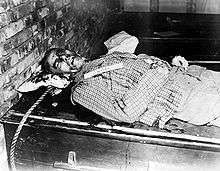 The body of Wilhelm Frick
The body of Wilhelm Frick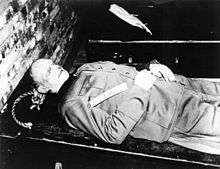 The body of Alfred Jodl
The body of Alfred Jodl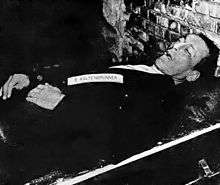 The body of Ernst Kaltenbrunner
The body of Ernst Kaltenbrunner The body of Wilhelm Keitel
The body of Wilhelm Keitel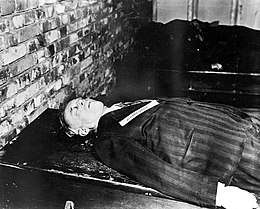 The body of Joachim von Ribbentrop
The body of Joachim von Ribbentrop The body of Alfred Rosenberg
The body of Alfred Rosenberg The body of Fritz Sauckel
The body of Fritz Sauckel The body of Arthur Seyss-Inquart
The body of Arthur Seyss-Inquart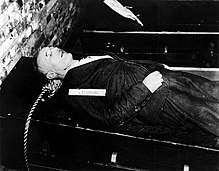 The body of Julius Streicher
The body of Julius Streicher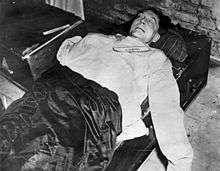 The body of Hermann Göring
The body of Hermann Göring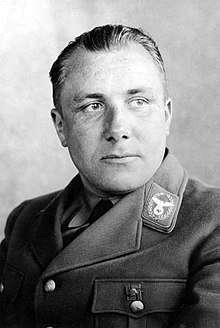 Martin Bormann was sentenced to death in absentia.
Martin Bormann was sentenced to death in absentia.
References
- By The Neck Until Dead: The Gallows of Nuremberg by Stanley Tilles with Jeffrey Denhart, Jona Books, Indiana: USA.
- Time Magazine coverage, 28 October 1946, pg. 34.
- Joseph Kingsbury-Smith: The Execution of Nazi War Criminals Archived 21 September 2012 at the Wayback Machine. Eyewitness Report; accessed 14 March 2018.
- Turley, Mark (1 September 2008). "From Nuremberg to Nineveh". Lulu.com – via Google Books.
- Shnayerson, Robert (October 1996). "Judgment at Nuremberg" (PDF). Smithsonian Magazine. pp. 124–141. Archived from the original (PDF) on 30 April 2011.
The trial removed 11 of the most despicable Nazis from life itself. In the early morning hours of Wednesday, October 16, 1946, ten men died in the courthouse gymnasium in a botched hanging that left some strangled to death for as long as 25 minutes.
- "The Trial of the Century– and of All Time, part two". Flagpole Magazine. 17 July 2002. p. 6. Archived from the original on 2 March 2009.
the experienced Army hangman, Master Sgt. John C. Woods, botched the execution. A number of the hanged Nazis died, not quickly from a broken neck as intended, but agonizingly from slow strangulation. Ribbentrop and Sauckel each took 14 minutes to choke to death, while Keitel, whose death was the most painful, struggled for 28 minutes at the end of the rope before expiring.
- "War Crimes: Night without Dawn", Time.com, 28 October 1946
- Spiegel Online, Nürnberger Prozesse: Der Tod durch den Strick dauerte 15 Minuten (German), 16 January 2007.
- Overy, Richard (2001). Interrogations: The Nazi Elite in Allied Hands. London: Allen Lane. ISBN 0-7139-9350-2.CS1 maint: ref=harv (link), pg. 205
- "Archived copy". Archived from the original on 21 September 2012. Retrieved 21 September 2012.CS1 maint: archived copy as title (link)
- Bloch, p. 456.
- Andrus, Burton C., I Was the Nuremberg Jailor, New York: Coward-McCann, 1969, p. 195.